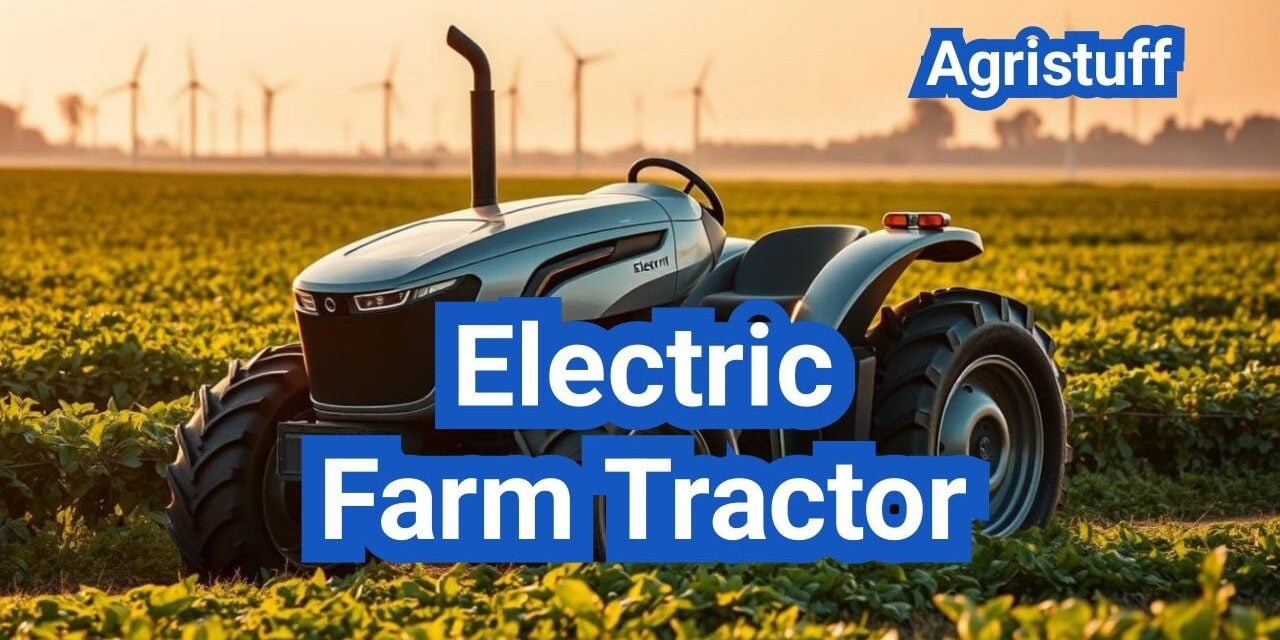The agricultural industry is witnessing a significant shift towards sustainable agriculture equipment, driven by the need for reduced environmental impact and lower operating costs. At the forefront of this change are eco-friendly farming machinery alternatives, such as the electric farm tractor.
As farmers increasingly look for cost-effective and environmentally friendly solutions, the demand for electric tractors is on the rise. These modern machines offer numerous benefits, including reduced operating costs and improved performance. This article will explore the key aspects of electric farm tractors, including their availability, charging options, and total cost of ownership.
Key Takeaways
- The growing importance of sustainable agriculture equipment in modern farming.
- The benefits of electric farm tractors, including reduced operating costs and environmental impact.
- An overview of the availability and charging options for electric tractors.
- The total cost of ownership for electric farm tractors compared to traditional diesel-powered tractors.
- The future prospects of eco-friendly farming machinery in the agricultural industry.
The Evolution of Electric Farm Tractors in American Agriculture
Electric farm tractors are revolutionizing U.S. agriculture, offering a cleaner, more efficient alternative to traditional diesel-powered equipment. The shift towards electric farm tractors is driven by a combination of environmental concerns, economic benefits, and technological advancements.
Current Market Landscape in the USA
The market for electric farm tractors in the United States is rapidly expanding. Several key players have entered the market, offering a range of models designed for different agricultural needs. According to industry reports, the demand for electric farm tractors is expected to grow significantly over the next decade, driven by government incentives, declining battery costs, and increasing awareness of the environmental benefits of electric-powered farming vehicles.
Environmental and Economic Drivers
The adoption of electric farm tractors is driven by both environmental and economic factors. Environmentally, electric tractors offer a significant reduction in greenhouse gas emissions and air pollution compared to their diesel counterparts. Economically, electric tractors can provide lower operating costs over their lifespan, primarily due to reduced fuel and maintenance costs. A study comparing the total cost of ownership of electric versus diesel tractors found that electric tractors can offer substantial savings, especially for farms with high tractor usage.
| Cost Component | Diesel Tractor | Electric Tractor |
|---|---|---|
| Initial Purchase Price | $100,000 | $120,000 |
| Fuel/Maintenance Costs (5 years) | $50,000 | $20,000 |
| Total Cost of Ownership (5 years) | $150,000 | $140,000 |
Transition Timeline from Diesel to Electric
The transition from diesel to electric farm tractors is expected to accelerate over the next decade. Industry analysts predict that by 2030, electric tractors could account for a significant share of new tractor sales in the United States. This transition will be supported by ongoing advancements in battery technology, charging infrastructure, and government policies promoting the adoption of renewable energy farming practices.
As the agricultural sector continues to evolve, the role of electric farm tractors is likely to expand, driven by their environmental benefits, economic advantages, and improving performance characteristics. Farmers and agricultural businesses considering the transition to electric tractors should evaluate their specific needs, assess the available models, and explore the incentives available to support their adoption.
Understanding Electric Farm Tractor Technology

Electric farm tractors represent a significant shift in farming technology, offering numerous benefits over traditional diesel tractors. These modern machines are powered by electric motors, using energy stored in advanced battery systems.
How Electric Tractors Work
Electric tractors operate on electric motors, which are powered by rechargeable batteries. These batteries can be charged from various power sources, including the grid and renewable energy sources like solar or wind power. The electric motor provides instant torque, making electric tractors highly efficient for various farming tasks.
Key Features of Electric Tractors:
- Zero emissions
- Lower operating costs
- Reduced noise pollution
- Instant torque for improved performance
Key Components and Battery Systems
The battery is a crucial component of an electric tractor. Modern electric tractors use advanced lithium-ion batteries, which offer high energy density and long cycle life. The battery management system ensures optimal performance and longevity of the battery.
Battery Specifications:
| Specification | Description | Typical Value |
|---|---|---|
| Capacity | Total energy storage | 100 kWh |
| Voltage | Operating voltage of the battery | 600 V |
| Cycle Life | Number of charge/discharge cycles | 3000 cycles |
Performance Comparison with Traditional Diesel Tractors
Electric tractors offer several performance advantages over traditional diesel tractors. They provide instant torque, which improves their ability to handle heavy loads and challenging terrain. Additionally, electric tractors have fewer moving parts, reducing the need for maintenance.
Comparison of Electric and Diesel Tractors:
| Feature | Electric Tractor | Diesel Tractor |
|---|---|---|
| Emissions | Zero | High |
| Operating Cost | Lower | Higher |
| Noise Level | Lower | Higher |
| Maintenance | Reduced | Higher |
Types of Electric Farm Tractors Available in the USA
The US market offers a diverse range of electric farm tractors catering to various agricultural needs. These tractors are designed to provide efficient, sustainable, and cost-effective solutions for different farming operations.
Electric Utility Tractors
Electric utility tractors are versatile machines used for a variety of tasks on farms and ranches. They are ideal for tasks that require moderate power and are known for their maneuverability and ease of use.
Key Features: Compact design, suitable for small to medium-sized farms, and capable of handling tasks like mowing, hauling, and loader work.
Electric Garden Tractors
Electric garden tractors are designed for smaller scale farming and gardening tasks. They are perfect for maintaining gardens, orchards, and small farms where larger machinery might be impractical.
Benefits: Environmentally friendly, reduced noise pollution, and lower operating costs.
Electric Agricultural Tractors
Electric agricultural tractors are built for heavy-duty farming operations. They offer significant power and are capable of performing tasks that traditionally require diesel-powered tractors.
Advantages: High torque, efficient power delivery, and reduced maintenance compared to traditional diesel tractors.
Electric Orchard and Vineyard Tractors
These tractors are specifically designed for use in orchards and vineyards, where their compact size and maneuverability are particularly valuable.
Special Features: Narrow profiles to navigate between rows of trees or vines, and specialized tires to minimize soil compaction.
| Tractor Type | Primary Use | Key Features |
|---|---|---|
| Electric Utility Tractors | General farm tasks | Compact, versatile, moderate power |
| Electric Garden Tractors | Gardening and small farm tasks | Environmentally friendly, low noise, low operating costs |
| Electric Agricultural Tractors | Heavy-duty farming | High torque, efficient power, reduced maintenance |
| Electric Orchard and Vineyard Tractors | Orchard and vineyard management | Narrow profiles, specialized tires, minimal soil compaction |
The variety of electric farm tractors available in the USA allows farmers to choose the most appropriate machinery for their specific needs, enhancing efficiency and reducing environmental impact.
Top Electric Farm Tractor Models in 2025

The electric farm tractor market is rapidly evolving with several top models emerging in 2025. This year is witnessing significant innovations in electric tractor technology, with various manufacturers introducing advanced models that promise to revolutionize farming practices.
Monarch MK-V Tractor Specifications
The Monarch MK-V tractor is one of the most anticipated electric farm tractors of 2025. It boasts a high-capacity battery that provides extended runtime, making it suitable for large-scale farming operations. The MK-V also features advanced autonomous capabilities, allowing for precise farming and reduced labor costs.
Key specifications of the Monarch MK-V include:
- Maximum power output: 100 kW
- Battery capacity: 250 kWh
- Runtime: Up to 12 hours
- Autonomous features: Level 4 autonomy
New Holland T4 Electric Power Features
New Holland’s T4 Electric Power tractor is another notable model in 2025. This tractor is designed for efficient farming operations and features a robust electric powertrain. The T4 Electric Power offers a smooth and quiet operation, reducing noise pollution and improving working conditions for farmers.
Key features of the New Holland T4 Electric Power include:
- Electric motor power: 75 kW
- Battery type: Lithium-ion
- Charging time: 2 hours with fast charging
- Transmission: Electric CVT
John Deere Electric Prototypes
John Deere has been at the forefront of agricultural innovation, and their electric prototypes for 2025 are no exception. These prototypes are designed to offer high performance and advanced technology, including autonomous features and precision farming capabilities.
While specific details are still under wraps, the prototypes are expected to feature:
- Advanced battery technology
- Enhanced autonomous features
- Integration with John Deere’s farm management systems
Other Notable Models and Manufacturers
Apart from the Monarch MK-V and New Holland T4 Electric Power, other manufacturers are also making significant contributions to the electric farm tractor market in 2025. Companies like Case IH and Fendt are expected to release their own electric models, further expanding the range of options available to farmers.
These emerging models are not only improving performance and efficiency but are also contributing to a more sustainable farming future by reducing emissions and environmental impact.
Evaluating Electric Tractor Performance for Your Farm
Farmers considering electric tractors must evaluate their performance to ensure they meet the farm’s specific requirements. This assessment involves several key factors that directly impact the tractor’s efficiency and productivity.
Power and Torque Requirements by Farm Type
Different farm types have unique power and torque requirements. For instance, small farms with lighter tasks may require less powerful tractors, while large agricultural enterprises need tractors with higher power and torque to handle heavy-duty tasks.
- Small farms: 20-50 HP
- Medium farms: 50-100 HP
- Large farms: 100+ HP
Understanding these requirements is crucial for selecting the right electric tractor.
Runtime and Battery Capacity Planning
Runtime is a critical factor in electric tractor performance. Farmers need to consider the battery capacity and how it aligns with their operational needs. A tractor with insufficient battery capacity may not complete tasks efficiently.
| Farm Size | Average Runtime Required | Recommended Battery Capacity |
|---|---|---|
| Small | 4-6 hours | 20-30 kWh |
| Medium | 6-8 hours | 30-50 kWh |
| Large | 8+ hours | 50+ kWh |
Operational Capabilities in Different Conditions
Electric tractors must perform well in various conditions, including different terrains and weather. Their operational capabilities can significantly impact farm productivity.
Performance in Extreme Weather
Extreme weather conditions, such as high temperatures or freezing cold, can affect electric tractor performance. Understanding how different models perform in these conditions is vital for maintaining productivity year-round.
For example, some electric tractors are designed with thermal management systems to maintain optimal battery performance in extreme temperatures.
Charging Infrastructure for Electric Farm Tractors

A well-planned charging infrastructure is crucial for the successful integration of electric farm tractors into agricultural practices. As farmers transition to electric vehicles, understanding the various charging options and their implementation becomes essential.
CCS Fast Charging Implementation
CCS (Combined Charging System) fast charging is a critical component of electric farm tractor infrastructure. It enables rapid recharging, minimizing downtime and increasing productivity.
- Key Benefits: Reduced charging time, increased operational efficiency
- Implementation Considerations: Compatibility with tractor models, power supply requirements
J1772 Farm Charger Installation Guide
The J1772 charger is a widely adopted standard for electric vehicle charging. Installing a J1772 farm charger requires careful planning to ensure compatibility and safety.
- Assess your farm’s electrical infrastructure
- Choose a suitable J1772 charger model
- Ensure proper installation by a certified electrician
Battery Swap Systems: Logistics and Requirements
Battery swap systems offer an alternative to traditional charging methods, allowing for quick replacement of depleted batteries with fully charged ones.
- Logistical Considerations: Battery storage, handling equipment, trained personnel
- Requirements: Standardized battery designs, swap station infrastructure
Integration with Existing Farm Electrical Infrastructure
Integrating electric farm tractor charging infrastructure with existing farm electrical systems is vital for efficient operation.
Key considerations include:
- Assessing current electrical capacity
- Upgrading infrastructure as necessary
- Implementing energy management systems
By carefully planning and implementing charging infrastructure, farmers can maximize the benefits of electric farm tractors, enhancing productivity while reducing environmental impact.
How to Implement Solar EV Charging on Your Farm

Solar EV charging offers farmers a sustainable and cost-effective solution for powering their electric tractors. As the agricultural industry continues to adopt electric vehicles, integrating solar energy into farm operations becomes increasingly important.
Solar Array Sizing and Configuration Steps
To implement solar EV charging effectively, determining the appropriate size and configuration of your solar array is crucial. This involves assessing your farm’s energy needs, available space for solar panels, and the specific requirements of your electric tractors.
- Calculate daily energy consumption of your electric tractors
- Assess available roof or land space for solar panel installation
- Choose high-efficiency solar panels suitable for your farm’s climate
- Consider battery storage needs for continuous operation
According to a study by the National Renewable Energy Laboratory, “solar-powered farms can reduce their carbon footprint significantly, contributing to a cleaner environment.”
“The integration of solar energy with electric farm equipment represents a significant step towards sustainable agriculture.”
| Solar Array Size | Energy Production | Tractor Charging Capacity |
|---|---|---|
| 10 kW | 40 kWh/day | 2-3 tractors |
| 20 kW | 80 kWh/day | 4-6 tractors |
| 50 kW | 200 kWh/day | 10+ tractors |
Energy Storage Solutions Selection
Energy storage is a critical component of a solar EV charging system. Selecting the right energy storage solution depends on your farm’s specific needs and the size of your solar array.
Key considerations include:
- Battery capacity and depth of discharge
- Compatibility with your solar array and charging infrastructure
- Scalability for future expansion
- Warranty and lifespan of the storage system
Creating an Energy Independent Farm System
An energy-independent farm system integrates solar power generation, energy storage, and EV charging to create a self-sufficient energy ecosystem.
This involves:
- Designing a comprehensive energy management system
- Implementing smart charging technologies
- Monitoring and optimizing energy usage
- Ensuring system redundancy and backup power
Connecting Solar Arrays to Charging Infrastructure
The final step in implementing solar EV charging is connecting your solar array to your farm’s charging infrastructure. This requires careful planning to ensure efficient energy transfer and safe operation.
Key steps include:
- Installing a compatible inverter to convert DC power to AC
- Configuring the charging system to prioritize solar energy
- Implementing safety measures such as ground fault protection
- Monitoring system performance and adjusting as necessary
Electric Farm Tractor Maintenance Guide

Maintaining your electric farm tractor is essential for maximizing its productivity and lifespan. Regular maintenance not only ensures optimal performance but also helps in reducing downtime and extending the overall life of the tractor.
Daily and Weekly Maintenance Checklist
To keep your electric farm tractor in top condition, follow this daily and weekly maintenance checklist:
- Daily: Check the battery level and charge the tractor if necessary.
- Daily: Inspect tires for proper inflation and signs of wear.
- Weekly: Clean the tractor, paying special attention to the battery contacts and electrical connectors.
- Weekly: Check all fluid levels, including coolant and hydraulic fluids.
Battery Care and Management Best Practices
Proper battery care is crucial for the longevity and performance of your electric farm tractor. Here are some best practices:
- Monitor battery health regularly using built-in diagnostics or external tools.
- Avoid deep discharging; charge the battery when it falls below 20% capacity.
- Store the tractor in a cool, dry place when not in use to prolong battery life.
- Follow the manufacturer’s guidelines for charging and maintenance.
Common Issues and Troubleshooting Steps
Despite regular maintenance, issues can arise. Here are some common problems and troubleshooting steps:
- Reduced Range: Check for any parasitic drains, ensure proper tire inflation, and verify that the battery is holding a charge.
- Slow Charging: Inspect the charging system, including the charger and connectors, for any signs of damage or wear.
- Error Messages: Refer to the user manual or contact the manufacturer for guidance on resolving error messages.
Maintenance Cost Comparison with Diesel Tractors
Electric farm tractors generally have lower maintenance costs compared to their diesel counterparts. Here’s a comparison:
| Maintenance Item | Electric Tractor | Diesel Tractor |
|---|---|---|
| Oil Changes | Not Required | $500/year |
| Filter Replacements | Minimal | $200/year |
| Battery Maintenance | $100/year | $50/year |
By following this maintenance guide, you can ensure your electric farm tractor remains in optimal condition, providing reliable service and maximizing your investment in sustainable farm machinery.
Navigating Financial Incentives for Electric Tractor Adoption
As the agricultural sector shifts towards more sustainable practices, financial incentives play a crucial role in the adoption of electric tractors. The initial investment in electric tractors can be substantial, but various incentives can significantly reduce the financial burden.
Federal Tax Credits and Rebates Application Process
The federal government offers tax credits to encourage the adoption of electric tractors. To apply, farmers must follow a specific process:
- Ensure the electric tractor model is eligible for the tax credit.
- Gather required documentation, including proof of purchase and tractor specifications.
- File Form 8910 with the IRS to claim the credit.
Maximizing the tax credit: Farmers should consult with a tax professional to ensure they meet all eligibility criteria and follow the correct application process.
State-Level Incentive Programs by Region
In addition to federal incentives, many states offer their own programs to encourage the adoption of electric tractors. These can include rebates, grants, and special low-interest loans. For example:
| State | Incentive Type | Maximum Amount |
|---|---|---|
| California | Rebate | $50,000 |
| Oregon | Grant | $30,000 |
| Illinois | Low-interest Loan | $100,000 |
Farmers should check with their state’s energy or agriculture department to explore available incentives.
USDA and Agricultural Grants Application Guide
The USDA offers various grant programs that can support the adoption of electric tractors, particularly those that promote renewable energy and sustainable farming practices. To apply:
- Review the USDA’s grant opportunities, such as the Rural Energy for America Program (REAP).
- Prepare a detailed project proposal, including budget and expected outcomes.
- Submit the application through the USDA’s online portal.
Tip: Applicants should highlight how their electric tractor adoption aligns with the USDA’s priorities on renewable energy and sustainability.
Combining Multiple Incentive Programs
Farmers can often combine federal, state, and USDA incentives to maximize their benefits. For instance, a farmer could claim the federal tax credit, receive a state rebate, and secure a USDA grant. Careful planning is essential to ensure compliance with all program requirements.
By navigating these financial incentives effectively, farmers can make the transition to electric tractors more economically viable, contributing to a more sustainable agricultural sector.
Calculating Total Cost of Ownership (TCO) for Electric Farm Tractors
The total cost of ownership for electric farm tractors encompasses more than just the initial purchase price. It involves a comprehensive analysis of various factors that contribute to the overall cost-effectiveness of these tractors over their lifespan.
Initial Purchase Considerations and Financing
When considering the purchase of an electric farm tractor, the initial cost is a significant factor. This includes not only the purchase price but also financing costs, if applicable. Farmers should explore available financing options and incentives that can help offset the initial investment.
Financing Options: Leasing, loans, and grants are available for farmers looking to adopt electric tractors. Understanding the terms and conditions of these options is crucial.
Operational Cost Comparison Methodology
Comparing the operational costs of electric tractors with their diesel counterparts is essential. This involves analyzing fuel costs (electricity vs. diesel), maintenance expenses, and other operational expenditures.
| Cost Component | Electric Tractor | Diesel Tractor |
|---|---|---|
| Fuel/Electricity | $0.05/kWh | $2.50/gallon |
| Maintenance | Lower | Higher |
Long-Term ROI Analysis Framework
Conducting a long-term Return on Investment (ROI) analysis is vital for understanding the financial benefits of electric tractors. This involves calculating the payback period and comparing it with the tractor’s lifespan.
ROI Calculation: ROI = (Gain from Investment – Cost of Investment) / Cost of Investment. For electric tractors, the gain includes savings on fuel and maintenance.
Using Farm TCO Calculators: Step-by-Step Guide
Farm TCO calculators are valuable tools for farmers to estimate the total cost of ownership. Here’s a step-by-step guide to using these calculators:
- Input the purchase price and financing costs.
- Enter operational costs, including electricity or fuel expenses.
- Include maintenance and repair costs.
- Factor in any incentives or tax credits.
By following these steps and considering all the relevant factors, farmers can make informed decisions about adopting electric farm tractors.
Practical Applications of Electric Tractors on American Farms

The practical applications of electric tractors are being explored and implemented across different types of farming in America. These tractors are proving to be versatile and beneficial for various agricultural operations.
Small Farm Operations Case Studies
Small farms are among the early adopters of electric tractors, leveraging their benefits for daily operations. For instance, a case study on a 20-acre farm in California showed that electric tractors reduced operational costs by 30% and decreased noise pollution, creating a more pleasant working environment.
- Reduced Operational Costs: Electric tractors offer significant savings on fuel and maintenance.
- Environmental Benefits: Zero emissions contribute to a cleaner environment and help farms comply with environmental regulations.
- Increased Efficiency: Electric tractors provide instant torque, improving performance in various farming tasks.
Medium to Large Agricultural Enterprise Implementation
Medium to large agricultural enterprises are also adopting electric tractors as part of their fleet. These enterprises benefit from the scalability of electric tractor technology, allowing them to transition their operations gradually.
A notable example is a 500-acre corn and soybean farm in Iowa, which integrated electric tractors into their operations. The farm reported a 25% reduction in overall energy costs and a significant decrease in maintenance downtime.
- Assessing energy needs and infrastructure requirements.
- Gradual integration of electric tractors into existing fleets.
- Monitoring performance and adjusting operations accordingly.
Specialty Farming Applications and Success Stories
Specialty farming, including orchard and vineyard management, is also benefiting from electric tractors. These tractors offer precise control and maneuverability, which are crucial in specialty farming operations.
A vineyard in Oregon successfully implemented electric tractors for their daily operations, citing the benefits of reduced noise and zero emissions, which improved working conditions for their staff.
Adapting Traditional Farm Practices for Electric Equipment
Adapting traditional farm practices to electric equipment requires some adjustments but offers numerous benefits. Farmers need to understand the capabilities and limitations of electric tractors to maximize their use.
Training programs for farmers on the operation and maintenance of electric tractors are essential for successful adoption. Additionally, leveraging technology such as precision agriculture and farm management software can enhance the efficiency of electric tractor operations.
Benefits Beyond Economics: Low Noise and Zero Emission Tractors

Electric farm tractors are revolutionizing agriculture with benefits that extend far beyond cost savings. As farmers transition to these eco-friendly machines, they experience a range of advantages that improve their operations, their workers’ health, and their relationship with the surrounding community.
Low Noise Tractor Advantages in Various Settings
One of the significant benefits of electric tractors is their low noise operation. Traditional diesel tractors can generate noise levels that exceed 90 decibels, potentially causing hearing damage to operators over time. In contrast, electric tractors operate at much lower decibel levels, creating a safer and more comfortable working environment.
The reduced noise of electric tractors also has practical applications in various farming settings:
- Early morning or late evening operations are less likely to disturb nearby residential areas.
- Operators can communicate more easily with each other without having to shout over the noise of the tractor.
- Noise-sensitive tasks, such as working near livestock or in areas with noise-restricted regulations, become more manageable.
Environmental Impact Measurement of Zero Emission Tractors
Electric tractors produce zero tailpipe emissions, significantly reducing the environmental impact of farming operations. This is particularly beneficial in sensitive ecosystems or areas with strict environmental regulations.
| Emission Type | Diesel Tractor | Electric Tractor |
|---|---|---|
| CO2 Emissions | High | Zero |
| NOx Emissions | High | Zero |
| Particulate Matter | Present | Absent |
Worker Health and Safety Improvements
The transition to electric tractors also brings significant improvements in worker health and safety. With zero emissions, farmers and operators are no longer exposed to harmful diesel exhaust fumes, reducing the risk of respiratory problems and other health issues associated with prolonged exposure to diesel emissions.
Additionally, electric tractors typically have fewer moving parts than their diesel counterparts, potentially reducing maintenance requirements and the risk of accidents during maintenance.
Community Relations and Regulatory Compliance
The adoption of electric tractors can also enhance a farm’s relationship with its surrounding community. By reducing noise and air pollution, farms can become better neighbors, potentially easing regulatory hurdles and improving public perception.
Furthermore, as regulations around emissions and noise pollution become stricter, farms using electric tractors will be better positioned to comply with these new standards, potentially avoiding costly fines or operational restrictions.
Autonomous Features in Modern Electric Farm Tractors
The advent of autonomous features in electric farm tractors marks a new era in agricultural technology. As farming becomes increasingly sophisticated, the integration of autonomous capabilities is set to transform the industry.
Current Autonomous Capabilities Overview
Modern electric farm tractors are equipped with advanced autonomous features that enhance their functionality and efficiency. These capabilities include:
- Precision navigation and control
- Automated task execution
- Real-time monitoring and adjustments
- Integration with farm management software
These features allow farmers to optimize their operations, reduce labor costs, and improve crop yields.
Integration with Farm Management Systems
The integration of autonomous electric tractors with farm management systems (FMS) is a critical aspect of modern farming. FMS platforms enable farmers to:
- Plan and schedule tasks more efficiently
- Monitor tractor performance in real-time
- Analyze data for better decision-making
- Optimize resource allocation
This integration enhances the overall productivity and sustainability of farming operations.
Data Collection and Analysis Benefits
Autonomous electric tractors are equipped with sensors and data collection systems that provide valuable insights into farming operations. The benefits of this data collection include:
| Data Type | Benefit |
|---|---|
| Soil Moisture Levels | Optimized irrigation scheduling |
| Crop Health Monitoring | Early detection of issues |
| Tractor Performance | Predictive maintenance |
This data-driven approach enables farmers to make informed decisions, reducing waste and improving yields.
Future Developments in Autonomous Farming Technology
The future of autonomous farming technology is promising, with ongoing advancements in AI, machine learning, and sensor technology. Expected developments include:
- Enhanced predictive analytics
- Improved tractor-to-tractor communication
- Advanced automation capabilities
- Integration with other smart farming technologies
These advancements will further solidify the role of autonomous electric tractors in modern agriculture.
Overcoming Challenges in Electric Tractor Adoption
Electric tractor adoption is not without its challenges, requiring careful consideration from farmers. As the agricultural industry continues to embrace electric vehicles, understanding and addressing these challenges is crucial for successful integration.
Addressing Range Anxiety and Runtime Concerns
One of the primary concerns farmers have when considering electric tractors is range anxiety. The fear of running out of charge during critical operations can be a significant deterrent. To address this, manufacturers are working on improving battery technology to increase runtime. For instance, some electric tractors now offer runtime of up to 10 hours on a single charge, depending on the task and terrain.
Farmers can also mitigate range anxiety by:
- Assessing their typical daily operational needs
- Investing in additional charging infrastructure
- Implementing efficient task scheduling to minimize peak demand periods
Planning Infrastructure Development in Phases
Developing the necessary charging infrastructure is a critical step in electric tractor adoption. Farmers should plan this development in phases, starting with assessing their current electrical infrastructure and identifying areas for upgrade or expansion.
A phased approach might include:
- Conducting an energy audit of the farm
- Installing initial charging points for the electric tractor fleet
- Gradually expanding charging infrastructure as the fleet grows
- Exploring renewable energy sources, such as solar, to power charging operations
Training Staff on New Technology
The introduction of electric tractors requires training for farm staff. This training should cover not only the operation of the new equipment but also maintenance and troubleshooting. Effective training programs can help reduce downtime and improve overall efficiency.
Key areas to focus on during staff training include:
- Understanding electric tractor controls and features
- Basic maintenance tasks, such as battery care and software updates
- Recognizing and addressing common issues
- Optimizing charging practices for maximum efficiency
Securing Technical Support and Service
Ensuring access to reliable technical support and service is crucial for maintaining the electric tractor fleet. Farmers should work closely with manufacturers and dealerships to establish comprehensive support agreements.
When evaluating technical support, consider factors such as:
- Response times for service requests
- Availability of loaner equipment during repairs
- Quality of customer support and technical resources
- Ongoing software updates and feature enhancements
By addressing these challenges proactively, farmers can ensure a smoother transition to electric tractors and maximize the benefits of this technology.
How to Select the Right Electric Farm Tractor for Your Needs
The process of selecting an electric farm tractor involves careful consideration of several factors to ensure it meets your farm’s specific needs. With various models available, understanding your farm’s requirements is crucial.
Assessing Your Farm’s Specific Requirements
To choose the right electric tractor, start by assessing your farm’s tasks and operations. Consider the types of tasks you need the tractor to perform, such as plowing, tilling, or hauling. Evaluate the terrain and soil conditions on your farm, as these factors can significantly impact the tractor’s performance and battery life.
Creating a list of your farm’s specific needs will help narrow down the options. Consider factors like the size of your farm, the typical load you need to carry, and any specific attachments you might need.
Matching Tractor Specifications to Farm Tasks
Once you have a clear understanding of your farm’s needs, it’s time to match these requirements with the specifications of available electric tractors. Look for tractors with sufficient power and torque to handle your tasks efficiently. Consider the battery capacity and estimated runtime to ensure it can operate for the duration you need.
Review the tractor’s compatibility with any attachments or implements you plan to use. Some electric tractors may offer more flexibility in this regard than others.
Evaluating Dealer Support and Service Networks
The level of support and service provided by the dealer is a critical factor in your decision. Look for dealers with a strong reputation for customer service and a comprehensive network of service centers. Reliable after-sales support can significantly reduce downtime and keep your operations running smoothly.
Consider the availability of training for your staff on the new equipment. A dealer that offers thorough training can help ensure you’re getting the most out of your electric tractor.
Test Drive and Demonstration Recommendations
Before making a final decision, it’s highly recommended to test drive the electric tractor. A test drive will give you a firsthand experience of the tractor’s performance, handling, and any features that are important to you.
Arrange for a demonstration with the dealer to see how the tractor operates under conditions similar to your farm. This can provide valuable insights into its suitability for your needs.
The Future of Electric Farm Tractors in American Agriculture
The future of electric tractors in American agriculture is promising, driven by advancements in technology and the need for sustainable farming practices. As discussed, electric farm tractors offer numerous benefits, including reduced operational costs, lower environmental impact, and improved performance.
With major manufacturers like John Deere and New Holland introducing electric tractor models, the industry is witnessing a significant shift towards eco-friendly farming machinery. The adoption of electric tractors is expected to increase, driven by government incentives and the growing demand for sustainable agriculture equipment.
As American agriculture continues to evolve, electric tractors will play a crucial role in shaping the future of farming. By embracing this technology, farmers can reduce their carbon footprint, improve efficiency, and contribute to a more sustainable food system. The future of electric tractors is bright, and their impact on American agriculture will be significant.
FAQ
What is an electric farm tractor?
An electric farm tractor is a tractor powered by an electric motor, using energy stored in batteries, which can be charged from various power sources, including renewable energy.
How do electric farm tractors work?
Electric tractors work by using electric motors to propel the tractor, with energy stored in batteries. The batteries can be charged from various power sources, including solar arrays and the grid.
What are the benefits of electric farm tractors?
Electric farm tractors offer numerous benefits, including reduced operating costs, lower environmental impact, improved performance, and lower noise levels.
What types of electric farm tractors are available?
There are various types of electric farm tractors available, including utility, garden, agricultural, and orchard/vineyard tractors, each designed to cater to specific farming needs.
How do I charge an electric farm tractor?
Electric farm tractors can be charged using CCS fast charging, J1772 farm chargers, or battery swap systems, and can be integrated with existing farm electrical infrastructure.
Can I use solar EV charging for my electric farm tractor?
Yes, solar EV charging is a viable option for powering electric farm tractors, offering a sustainable and cost-effective solution.
How do I maintain an electric farm tractor?
Electric farm tractors require regular maintenance, including daily and weekly checklists, battery care, and troubleshooting common issues.
Are there financial incentives for adopting electric farm tractors?
Yes, there are various financial incentives available, including federal tax credits, state-level programs, and USDA grants, which can help reduce the upfront costs of electric tractors.
How do I calculate the total cost of ownership for an electric farm tractor?
To calculate the total cost of ownership, consider initial purchase costs, operational costs, long-term ROI analysis, and use TCO calculators.
What are the advantages of autonomous features in electric farm tractors?
Autonomous features in electric farm tractors offer improved efficiency, data collection benefits, and future developments in autonomous farming technology.
How do I select the right electric farm tractor for my needs?
To select the right electric farm tractor, assess your farm’s specific requirements, match tractor specifications to tasks, evaluate dealer support, and consider test drives and demonstrations.
What are the challenges in adopting electric farm tractors?
Challenges in adopting electric farm tractors include range anxiety, infrastructure development, training staff, and securing technical support.
What is the future of electric farm tractors in American agriculture?
Electric farm tractors are likely to play an increasingly important role in sustainable farming practices, with ongoing advancements in technology and growing adoption.
Conclusion of: Electric Farm Tractor
Electric Farm Tractor in 2025—what it is, who it fits, and why now
An electric farm tractor replaces the diesel engine with a battery-electric drivetrain that delivers torque instantly, runs much quieter, and eliminates tailpipe emissions on the farm. For U.S. operations focused on orchards, vineyards, dairies, specialty crops, and loader work, an electric farm tractor can cut operating costs and improve air quality around people and livestock while aligning with sustainability goals. Anchor: U.S. DOE AFDC—EV basics & benefits
Electric Farm Tractor availability snapshot (USA, 2025)
As of 2025, the electric farm tractor market in the U.S. is real and growing: New Holland’s T4 Electric Power has entered low-horsepower utility segments; Monarch’s MK-V is in commercial production; and compact units like the Solectrac e25 target chores and specialty crops. Availability is still regional and dealer-dependent, but farmers can demo and order from manufacturer networks today. Anchor: New Holland—T4 Electric Power product page
Monarch MK-V—driver-optional electric farm tractor for specialty work
Monarch’s MK-V electric farm tractor launched commercial production in late 2022 and expanded manufacturing with Foxconn in 2023. It targets vineyard/orchard row widths, offers autonomous/driver-optional features, and charges on AC Level 2—about 5–6 hours with an 80-amp EVSE. Runtime varies by implement (Monarch publishes job-by-job expectations), and a swappable battery option supports extended shifts. Anchor: Monarch MK-V—official product & charging FAQ
New Holland T4 Electric Power—utility-class electric farm tractor
New Holland’s T4 Electric Power electric farm tractor is positioned for mixed farms, hay & forage, livestock, and municipal work. The tractor provides instant torque, lower noise, and zero tailpipe emissions; New Holland highlights up to 56% lower operating costs vs. diesel under certain duty cycles. It’s a fit where PTO/drawbar loads are moderate and daily runtime needs match the battery. Anchor: New Holland—T4 Electric Power specs & use cases
Solectrac e25—compact electric farm tractor for chores and grounds
For chores, mowing, and light loader tasks, the Solectrac e25 electric farm tractor offers a compact footprint and Level-2 charging convenience. It’s aimed at small farms, campuses, and equine or hobby operations that want zero-emission, low-noise operation near people and animals. Check dealer support and attachments before committing. Anchor: Solectrac e25 product sheet (specs & charging)
Where an electric farm tractor shines (and where it doesn’t—yet)
The electric farm tractor excels in low-to-moderate drawbar/PTO tasks—orchards, vineyards, dairies, greenhouses, feedlots, grounds maintenance—where stop-and-go torque, low noise, and clean air matter. Heavy primary tillage over long days still pushes today’s batteries; most makers position these models for utility roles rather than continuous high-draft work. Anchor: ThomasNet—T4 Electric Power applications & runtime
Runtime, weight, and soil considerations for an electric farm tractor
Plan your electric farm tractor duty cycle realistically: utility jobs often see 4–8 hours between charges, with longer runtime on lighter loads. Tractors are heavy—electric variants can be heavier still—which can help traction but warrants attention to soil compaction in wet conditions and headlands. Match ballast and tire inflation to the job. Anchor: Discussion of ag weight, runtime & use cases
Charging basics: Level-1, Level-2, and what most farms actually use
Most U.S. farms will charge an electric farm tractor on Level-2 AC (240V) using a J1772 EVSE on a dedicated circuit; Level-1 (120V) is far too slow for daily operations. Properly installed 40–80A Level-2 chargers can refill overnight, fitting chore schedules and avoiding peak rates. Anchor: DOE AFDC—charging levels overview
Connectors for an electric farm tractor: J1772 vs. CCS
In North America, an electric farm tractor typically uses the J1772 inlet for AC Level-1/Level-2 charging; some models (e.g., New Holland T4 Electric Power) add CCS Combo 1 for DC fast charging. CCS lets the same port accept both AC and DC plugs, simplifying hardware on the machine. Anchor: DOE AFDC—J1772 & CCS explained
DC fast charging on the farm for an electric farm tractor
Where turnaround time matters, a CCS-enabled electric farm tractor like the New Holland T4 Electric Power can use DC fast charging (up to 120 kW on supported hardware) to top up quickly between tasks. DCFC is powerful infrastructure—work with your utility on interconnection and rates before installing. Anchor: Dealer spec—DC fast up to 120 kW
Watch demand charges if you DC-fast-charge an electric farm tractor
Demand charges can dominate electricity costs when DC-fast-charging an electric farm tractor, especially if peak draws hit 50–150 kW or higher. Many farms avoid this with overnight Level-2 charging, on-site solar + storage, or managed charging to clip peaks. Talk with your co-op or IOU about agricultural time-of-use and demand-mitigation options. Anchor: NREL—DCFC economics & demand charges
REAP and renewables: funding angles for charging an electric farm tractor
USDA’s REAP can’t fund a stand-alone EV charger, but a charger bundled as part of a renewable energy system (e.g., solar-powered charging for your electric farm tractor) and not for retail fuel sales may be eligible. Many farms pair PV + storage with Level-2 charging to cut operating costs and grid peaks. Anchor: USDA REAP—EV charger eligibility FAQ
State incentives: California FARMER program for an electric farm tractor
Beyond federal programs, California’s FARMER grants through local air districts can help replace older equipment with cleaner tech—including an electric farm tractor where eligible. Similar programs may exist in your state via air districts or clean-ag initiatives. Anchor: CARB—FARMER program overview
Energy prices that drive the TCO of an electric farm tractor
TCO for an electric farm tractor hinges on your electricity and diesel prices. In mid-October 2025, the EIA reported a U.S. average on-highway diesel price of about $3.665/gal, while recent EIA data show commercial electricity averaging ~13 cents/kWh nationally (state-by-state varies). Update these inputs from your utility and fuel supplier before buying. Anchor: EIA—weekly U.S. diesel prices
Estimating diesel use for a TCO comparison vs. an electric farm tractor
A quick benchmark for replacing a diesel with an electric farm tractor: average diesel consumption ≈ 0.044 gal per PTO-hp per hour across mixed loads (ASABE-based extension method). Multiply 0.044 × your PTO hp to get gal/h, then multiply by your $/gal. This gives a fair baseline for chores vs. utility electric duty cycles. Anchor: Virginia Tech—diesel fuel use formula (0.044 gal/hp-h)
Worked example: a utility day with an electric farm tractor
Suppose you replace a 70-PTO-hp diesel with a similar-class electric farm tractor for loader + mowing chores at moderate load. Diesel: 0.044 × 70 ≈ 3.1 gal/h. At $3.665/gal, that’s ≈ $11.36/h (fuel only). Electric: assume 18–22 kWh/h net draw for similar work; at $0.13/kWh, ≈ $2.34–$2.86/h. Your spread (~$8–$9/h) funds the payment on the battery machine, offsetting higher upfront cost—actuals depend on duty cycle, rates, and charging strategy. Anchor: EIA—national average commercial electricity price
Maintenance, noise, and health advantages of an electric farm tractor
An electric farm tractor eliminates engine oil, filters, DEF, and many wear items, cutting routine service and downtime. Quieter machines reduce operator fatigue and improve conditions in barns and around workers, with no exhaust in enclosed spaces (still follow ventilation and battery-safety best practices). Anchor: DOE AFDC—EV maintenance savings
Charging hardware and connectors to spec for an electric farm tractor
Before delivery of an electric farm tractor, plan charging: most farms install 40–80A Level-2 J1772 EVSE on a dedicated 240V circuit sized by a licensed electrician. If your model supports CCS DCFC, confirm connector type, maximum kW, and site power to avoid surprises. Manufacturer spec sheets detail charger requirements and charge times. Anchor: Example—Monarch charger electrical specs
Reality check: matching jobs to battery capacity on an electric farm tractor
To get the most from an electric farm tractor, sequence high-draw tasks earlier in the day, keep blades sharp, manage ballast, and schedule a mid-day top-off if needed. For multi-shift work, evaluate DC top-ups, battery-swap options (if offered), or a two-tractor rotation to keep implements moving without range anxiety. Anchor: Operational tips—runtime & swap discussion
Is an electric farm tractor the right next purchase?
If your work pattern is utility-heavy, near people or livestock, and you can charge off-peak (or from on-farm solar), an electric farm tractor can lower total cost of ownership while improving the work environment. For continuous heavy tillage, consider a staged transition—start with one battery unit for chores, measure savings, and expand as models and battery capacities grow. Anchor: Peer-review—advantages/limitations of electrified tractors
Final thought
The electric farm tractor isn’t a one-size-fits-all replacement yet, but in the right fleet slot it already pencils out on fuel, maintenance, and uptime—especially when paired with managed charging and, where possible, on-farm renewables. Farmers who run a disciplined pilot (meter energy, log jobs, and track costs) are finding real, defensible savings they can scale. Anchor: EIA—end-use electricity cost trends
Sources & References
- New Holland—Agricultural Tractors
- Monarch MK-V—product & charging FAQ
- Monarch—charger electrical specifications (PDF)
- ThomasNet—T4 Electric Power use cases & runtime
- Virginia Tech Extension—diesel use estimate (0.044 gal/hp-h)
- EIA—U.S. on-highway diesel prices (weekly)
- EIA—average U.S. commercial electricity price
- NREL—DCFC profitability & demand charges (PDF)
- USDA REAP—EV charger eligibility
- CARB—FARMER program
- MDPI (2025)—Designing & optimizing electric tractors










